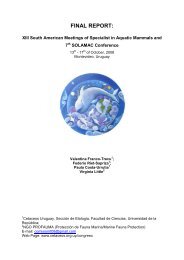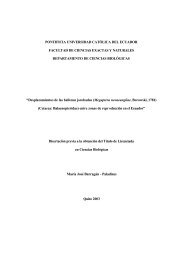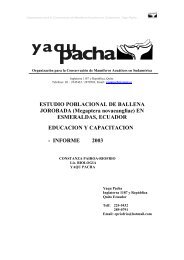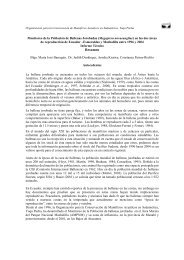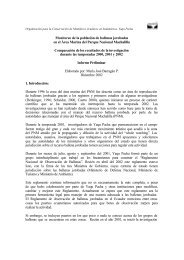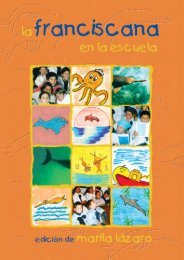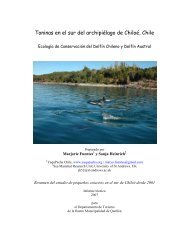Partial report - Yaqu Pacha
Partial report - Yaqu Pacha
Partial report - Yaqu Pacha
Create successful ePaper yourself
Turn your PDF publications into a flip-book with our unique Google optimized e-Paper software.
Introduction<br />
<strong>Partial</strong> <strong>report</strong><br />
The franciscana is endemic to coastal waters of central western South Atlantic, presenting close<br />
association with estuaries. The species is, perhaps, the most impacted cetacean in this region. Its restricted<br />
distribution makes it vulnerable to anthropogenic activities. In the past, data on incidental mortality of<br />
franciscana along the southern Brazilian coast were obtained from stranded carcasses. Since January<br />
1994 we monitored the unloading of about 15% of total coastal gillnet fleet that is composed by 140-150<br />
vessels. Our objectives were mainly to evaluate quali-quantitatively the mortality of the species in coastal<br />
gillnet fisheries and verify if by-catches of franciscanas are causing some impact to the studied<br />
population. At least 223 dolphins were indirectly taken in the southern region (Rio Grande area) of the<br />
study area since the beginning of the project. The captures occurred in nets set for sciaenid and<br />
pomatomid fish and the sizes of nets varied from 800 to 11000 m in length, from 3.0 to 14.0 m in depth,<br />
and from 9.0 to 16.0 cm stretch mesh, depending on the target species (see Secchi et al., 1997 for<br />
additional details on the fishing characteristics). About sixty percent of these incidentally caught dolphins<br />
were juveniles. The mean depth of captures was higher for males (25.2 m) than for females (22.0 m), but<br />
the differences were non-significant. Mean depths of capture were also higher for adult dolphins (25.9 m)<br />
than for juveniles (22.8 m), but differences were also non-significant. Mean depth of captures (24.7 m)<br />
were higher during austral winter months (cold water temperatures) than during austral summer months<br />
(22.9 m), but differences were again non-significant. Extrapolating our incidental capture estimates based<br />
on gear type and fishing effort, we estimated that between 600 and 700 franciscanas may have been taken<br />
only in 1994 (see combined results from Secchi et al., 1997, Kinas and Secchi, 1998, Ott, 1998 and<br />
Secchi, 1999).<br />
Data on total lengths frequency distribution; capture depths frequency distribution; monthly<br />
frequency distribution; proportion between sex and reproductive status are being collected. Furthermore,<br />
estimates on the number of annually caught animals are being calculated through different methods.<br />
Preliminary information on stock identity is herein <strong>report</strong>ed.<br />
Ongoing studies:<br />
Reproduction:<br />
The analysis of the reproductive status of captured animals is being assessed. Gonads are being<br />
weighed, measured and examined macroscopically, then preserved in buffered formalin for further<br />
histiological analysis. We have already collected the gonads of about 223 dolphins, some of which have<br />
already been analysed (see Danilewicz et al., 2000).<br />
© Projeto Toninhas – 2000. Not to be reproduced without written permission from the authors 1
Age determination<br />
Teeth are being taken from the lower jaw of incidentally caught animals in order to have their age<br />
determined through thin sections obtained on a freezing microtome and further staining.<br />
Blubber analysis:<br />
Samples of blubber and attached skin are also being taken for analysis of blubber composition,<br />
presence of contaminants and ultimately relationship with diet through stable isotope ratios. Although the<br />
franciscana’s habitat is restricted to coastal waters, where pollutants are expected to be concentrated,<br />
some preliminary results have indicated a low level of contamination by PCBs and DDTs, however, most<br />
samples came from young dolphins.<br />
Feeding habits:<br />
We collected stomachs of near 80 incidentally captured dolphins. The contents of about 30<br />
stomachs were removed for analysis of their diet. We found pieces of net (nylon) in two of these stomach<br />
contents and we believe that at least some of the dolphins got entangled because caught fish attracted<br />
them. We intend to verify the relationship between the incidental captures of franciscanas and the target<br />
species based on stomach content analysis. Franciscana feeds upon much smaller fish than commercially<br />
targetted ones. Additionally, we intend to compare the data obtained from stomach contents with isotope<br />
ratios and blubber composition to better assess individual diet.<br />
CPUE:<br />
Different units of effort are being currently tested in order to determine the best indicator of the<br />
magnitude of the captures. We are also testing the possibility of using the CPUE as an indicator of<br />
relative abundance of franciscanas in southern Brazil.<br />
Genetic studies<br />
Muscle samples for genetic based studies were taken from Rio Grande do Sul state (n=80) as<br />
well as additional samples were obtained with researchers from Argentina (n = 30), Uruguay (n=3), Santa<br />
Catarina (n = 4), Paraná (n= 10), São Paulo (n=13), Rio de Janeiro (n = 30) and Espirito Santo (n=1)<br />
covering the whole range of distribution. Preliminary results, using 10 samples from Rio de Janeiro and<br />
10 from Rio Grande do Sul, have already been published (see Secchi et al., 1998). The authors analysed<br />
about 418 base pairs in the D-loop region and 67 base pairs in the Pro-tRNA of the mtDNA. It was found<br />
five haplotypes in the North and 6 haplotypes in the South. Of most importance, we found no sharing of<br />
haplotypes between the groups. Further, a maximum likelihood analysis separates the haplotypes into two<br />
groups: a northern group of haplotypes and another containing the southern haplotypes. This study is<br />
ongoing and we plan to continue collecting tissue samples to provide our study with a larger sample size<br />
for subsampled areas. Additionally, we intend to start studies on kinship and social structure, which is<br />
© Projeto Toninhas – 2000. Not to be reproduced without written permission from the authors 2
still lacking for the species. Specific primers have been designed for Franciscana which will allow<br />
amplification of the most variable portion of the mtDNA control region (D-loop) and faster analysis of<br />
additional samples.<br />
As a result of our studies, two Bachelor and two Master theses have been produced, several<br />
abstracts were submitted and presented at international meetings and papers have been published. A list<br />
of these contributions follows.<br />
Related papers:<br />
BASSOI, M. 1997. Avaliação da dieta alimentar de toninha, Pontoporia blainvillei (Gervais &<br />
D’Orbigny, 1844), capturadas acidentalmente na pesca costeira de emalhe no sul do Rio Grande do<br />
Sul. BSc Dissertation. Fundação Universidade do Rio Grande. Rio Grande - RS. 68pp.<br />
CLAVER, J. A., E. R. SECCHI, I.L. MURIAS, A. ZERBINI and M. A. IÑIGUEZ. 1997<br />
Observaciones histológicas en ovarios de franciscana (Pontoporia blainvillei).(’Histological<br />
observations of the ovaries of franciscana dolphin (Pontoporia blainvillei)’. Third Workshop on<br />
the Research and Conservation of Franciscana Dolphins. Buenos Aires - Argentina. 26-28<br />
November, 1997.<br />
DANILEWICZ, D.S. 2000. Biologia reprodutiva e padrões de uso de habitat da toninha, Pontoporia<br />
blainvillei (Mammalia, Cetacea) no litoral do Rio grande do Sul, sul do Brasil. MSc<br />
Dissertation. PUC-RS. Porto Alegre.<br />
DANILEWICZ, D.S., E.R. SECCHI, P.H. OTT and J. CLAVER. 1998. Preliminary assessment of<br />
age at sexual maturity and reproductive rates of Pontoporia blainvillei from Rio Grande do Sul,<br />
Southern Brazil. VIII Reun. Trab. Esp. Mamíf. Aquát. América Sul. 25-29 de outubro. Olinda -<br />
Brasil. 63p. (Abstracts).<br />
DANILEWICZ, D.S., E.R. SECCHI, P.H. OTT, and I.B. MORENO (2000). Analyses of the<br />
age at sexual maturity and reproductive rates of franciscanas (Pontoporia blainvillei)<br />
from Rio Grande do Sul, southern Brazil. Comunicações do Museu de Ciências e<br />
Tecnologia da PUCRS, série zoologia. 13: 89-98.<br />
FIDÉLIX, L., M. BASSOI and E.R. SECCHI. 1998. Aspectos sócio-econômicos e culturais da<br />
utilização da toninha, Pontoporia blainvillei, pela comunidade pesqueira de Rio Grande, Rio<br />
Grande do Sul, Brasil. VIII Reun. Trab. Esp. Mam. Aquát. Amér. Sul. 25 a 29 outubro de 1998.<br />
Olinda, Brasil. 81p. (Abstracts).<br />
JUNIN, M., H. P. CASTELLO, E. R. SECCHI and I.B. MORENO. 1994. Analisis cuali y cuantitativo de<br />
organoclorados y metales pesados en mamíferos marinos del Atlántico Sudoccidental. Technical<br />
Report EF/2/DT/16. II Encontro sobre Coordenação de Pesquisa e Manejo da Franciscana.<br />
Florianópolis, SC.<br />
KINAS, P.G. and E.R. SECCHI. 1999. Modelling truncated data to estimate incidental kills of<br />
franciscana, Pontoporia blainvillei, by gillnets. ICES/SCOR Symposium on Ecosystem Effects<br />
of Fishing. 16 - 19 de março de 1999. Montpellier, França. (Abstracts).<br />
KINAS, P.G. and E.R. SECCHI. (1998). Modelling truncated data to estimate incidental kills of<br />
franciscana, Pontoporia blainvillei, by gillnets. Rep. Int. Whal. Commn. 48:533-536.<br />
MORENO, I.B., P.H. OTT, and D.S. DANILEWICZ. 1994. Análise preliminar do impacto da pesca<br />
artesanal costeira sobre Pontoporia blainvillei no litoral norte do Rio Grande do Sul, sul do<br />
© Projeto Toninhas – 2000. Not to be reproduced without written permission from the authors 3
Brasil. Proceedings of the 2 º Encontro sobre Coordenação de Pesquisa e Manejo da<br />
Franciscana. 22-23 de outubro de 1994. Florianópolis – Brasil. EF/2/DT8. pp 31-41.<br />
OTT, P.H. 1998. Análise das capturas acidentais de Pontoporia blainvillei (Gervais e D’Orbigny,<br />
1844) (Cetacea, Pontoporiidae) nas comunidades pesqueiras do litoral norte do Rio Grande do<br />
Sul, Sul do Brasil. MSc Dissertation. PUC-RS. Porto Alegre. 103 pp.<br />
OTT, P. H., E. R. SECCHI, E. A. CRESPO AND S. L. DANS. Estrutura etária da população de<br />
Pontoporia blainvillei acidentalmente capturada pela atividade pesqueira na costa do Rio<br />
Grande do Sul - Brasil. (‘Age structure of franciascana population incidentally caught in the<br />
coastal gillnet fishery in the Rio Grande do Sul State - Brazil’). Third Workshop on the<br />
Research and Conservation of Franciscana Dolphins. Buenos Aires - Argentina. 26-28<br />
November, 1997.<br />
SECCHI, E.R., . 1999. Taxa intrínseca de crescimento de uma população de toninhas, Pontoporia<br />
blainvillei (Gervais & D’Orbigny, 1846) (Cetacea, Pontoporiidae) sujeita a capturas<br />
acidentais na pesca costeira de emalhe no sul do Brasil. MSc Dissertation. Fundação<br />
Universidade do Rio Grande. Rio Grande - RS.<br />
SECCHI, E.R., BASSOI, M., DALLA ROSA, L., ROCHA-CAMPOS, C.C. and MÖLLER, L. 1995.<br />
Incidental captures of franciscanas, Pontoporia blainvillei (Cetacea, Pontoporiidae), in coastal<br />
gillnet fisheries along southern Rio Grande do Sul State - Brazil: evaluation of the problem. -<br />
Technical <strong>report</strong> to the Whale and Dolphin Conservation Society, Bath - UK. 21pp. (unpublished<br />
data).<br />
SECCHI, E.R. and P.H. OTT. 1997. The depth factor determining the distribution and abundance of<br />
franciscana, Pontoporia blainvillei, as demonstrated by a CPUE index approach. Technical<br />
<strong>report</strong>. III Taller para la Coordinación de la Investigación y la Conservación de la Franciscana<br />
en el Atlántico Sudoccidental. Buenos Aires. DT18.<br />
SECCHI, E. R., P. H. OTT, E. A. CRESPO, P. G. KINAS, S. N. PEDRAZA and P. BORDINO. In<br />
press. Abundance estimation of a franciscana dolphin, Pontoporia blainvillei, stock<br />
from aerial surveys. Rep. int. Whal. Commn.<br />
SECCHI, E.R., A.N. ZERBINI, M. BASSOI, L. DALLA ROSA, L.M. MOLLER and C.C.<br />
ROCCHA-CAMPOS. 1997a. Mortality of franciscanas, Pontoporia blainvillei, in coastal<br />
gillneting in southern Brazil: 1994-1995. Rep. Int. Whal. Commn. 47:653-658.<br />
SECCHI, E.R., L. DALLA ROSA, M. BASSOI and L. BARCELLOS. 1997b. Uma alternativa para<br />
minimizar o impacto das capturas acidentais de toninhas, Pontoporia blainvillei, na pesca costeira<br />
de emalhe no sul do Brasil. Proceedings of VII Latin-American Conference on the Sciences of the<br />
Sea - COLACMAR - Santos, Brazil.<br />
SECCHI, E.R., J.Y. WANG, B. MURRAY, C.C. ROCCHA-CAMPOS, and B.N. WHITE. 1998.<br />
Populational differences between franciscanas, Pontoporia blainvillei, from two geographical<br />
locations as indicated by sequences of mtDNA control region. Can. J. Zool. 76:1-6<br />
SECCHI, E.R and KINAS, P.G. 1999. Potential rates of increase of a franciscana stock under current<br />
levels of incidental mortality in coastal gillnet fisheries. 13th Biennial Conference on the<br />
Biology of Marine Mammals. 28 Nov - 03 Dec 1999, Wailea, Maui, Hawaii p. 169. (Abstracts).<br />
WALTER, T., P.G. KINAS and E.R. SECCHI. 1998. Comparação entre o crescimento de toninha<br />
Pontoporia blainvillei ocorrente no extremo sul do Brasil e no Uruguai. VII Reun. Trab. Esp.<br />
Mamíf. Aquát. América Sul. 25-29 outubro. Olinda-Brasil. 225p. (Abstracts).<br />
© Projeto Toninhas – 2000. Not to be reproduced without written permission from the authors 4
ANÁLISE ESTATÍSTICA DE CADERNOS DE BORDO E A MORTALIDADE DE<br />
FRANCISCANA, Pontoporia blainvillei, EM REDES DE EMALHE DA FROTA<br />
COSTEIRA DE RIO GRANDE (RS)*<br />
Kinas, P. G. 1 ; M. Muelbert 2 ; L. Fidelix 2 e E. R. Secchi 2<br />
1 Departamento de Matemática, Fundação Universidade Federal do Rio Grande, Cx.P. 474,<br />
Rio Grande-RS, Brasil, 96200-970. E. mail: dmtkinas@super.furg.br<br />
2 Laboratório de Mamíferos Marinhos, Museu Oceanográfico “Prof. Eliézer C. Rios” - FURG,<br />
Cx.P. 379, Rio Grande-RS, Brasil, 96200-970. E. mail: mamiferos@furg.br<br />
Com o objetivo de quantificar o impacto das capturas acidentais de franciscana, Pontoporia<br />
blainvillei, que ocorrem na pesca de emalhe costeira da frota que opera a partir do porto de<br />
Rio Grande, foram analisados cadernos de bordo obtidos com 5 mestres de embarcações<br />
desta frota. A participação foi voluntária. Para cada viagem eram fornecidas informações<br />
sobre número de dias no mar, local e profundidade do lançamento da rede, espécie-alvo da<br />
pescaria, tamanho da rede e número de toninhas capturadas. Os resultados descritos abaixo<br />
referem-se a um total de 235 viagens, distribuídas entre maio de 1998 e março de 2000. A<br />
maioria destes registros (73%) referem-se ao período agosto-dezembro. A espécies-alvo da<br />
pescaria foi a corvina em 70% dos registros e a pescada nos demais. Existe dependência entre<br />
espécie-alvo e local de pescarias (χ 2 =31,2; gl=4; p



